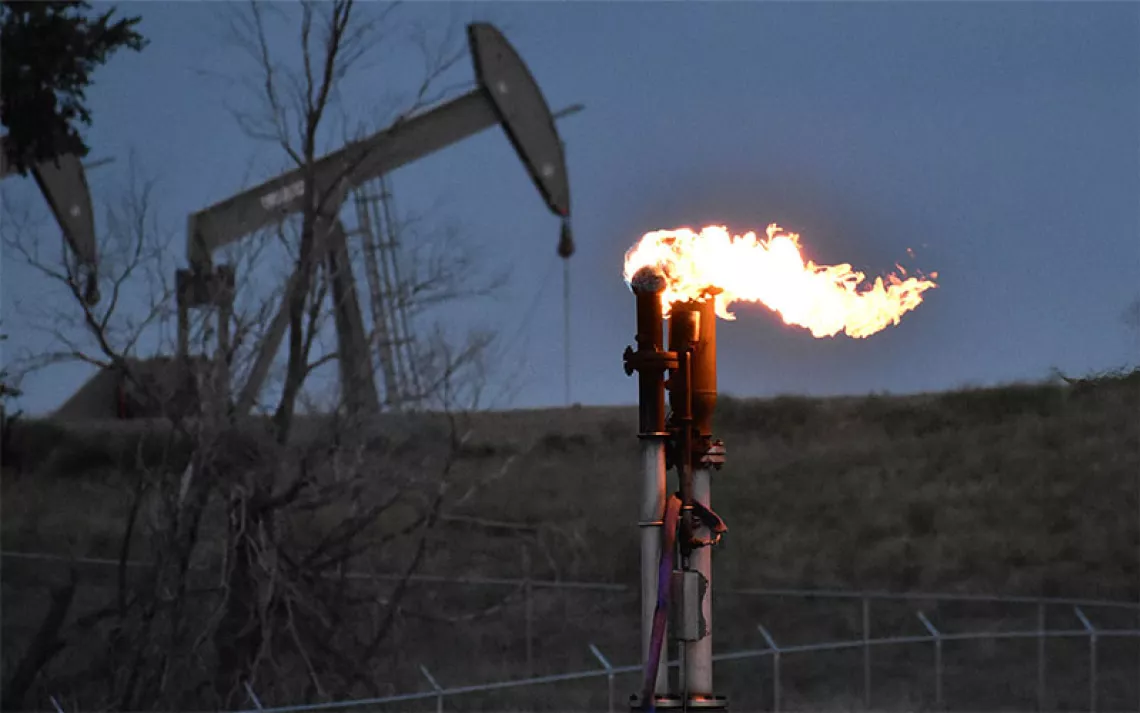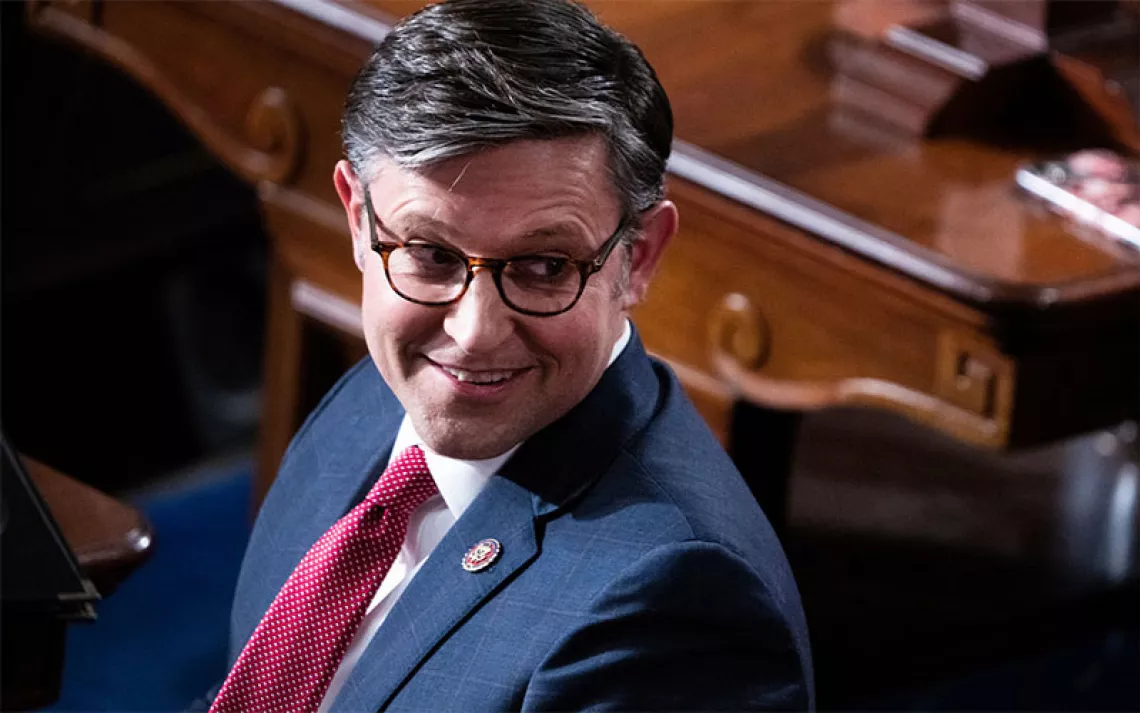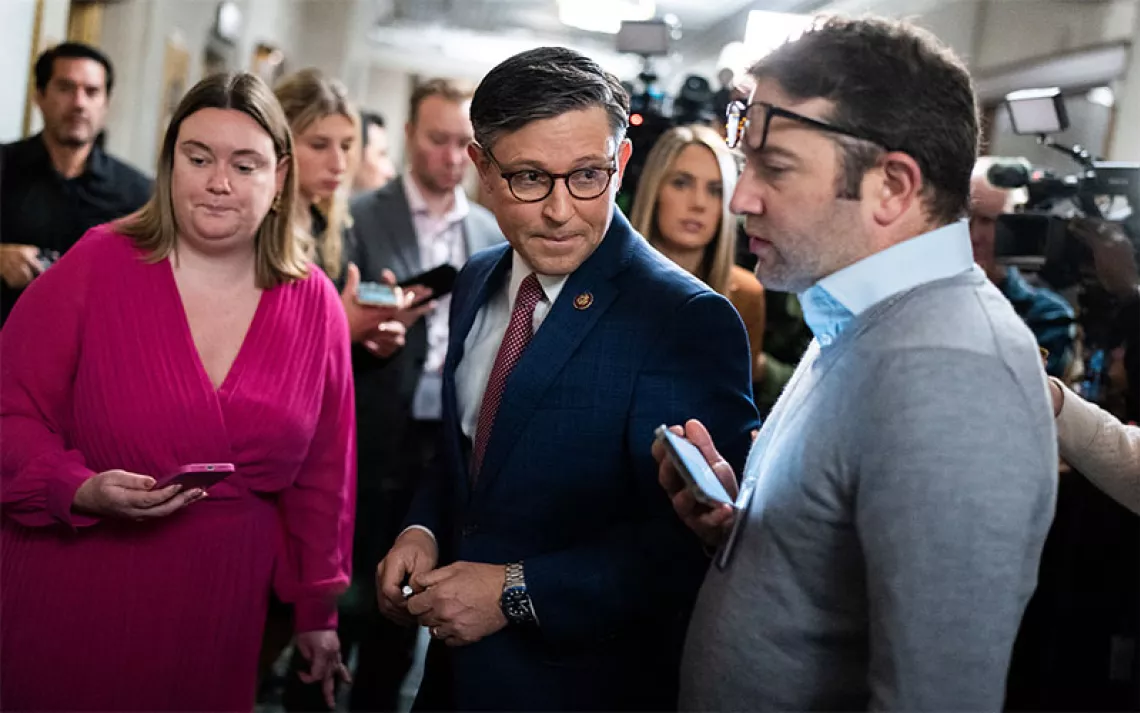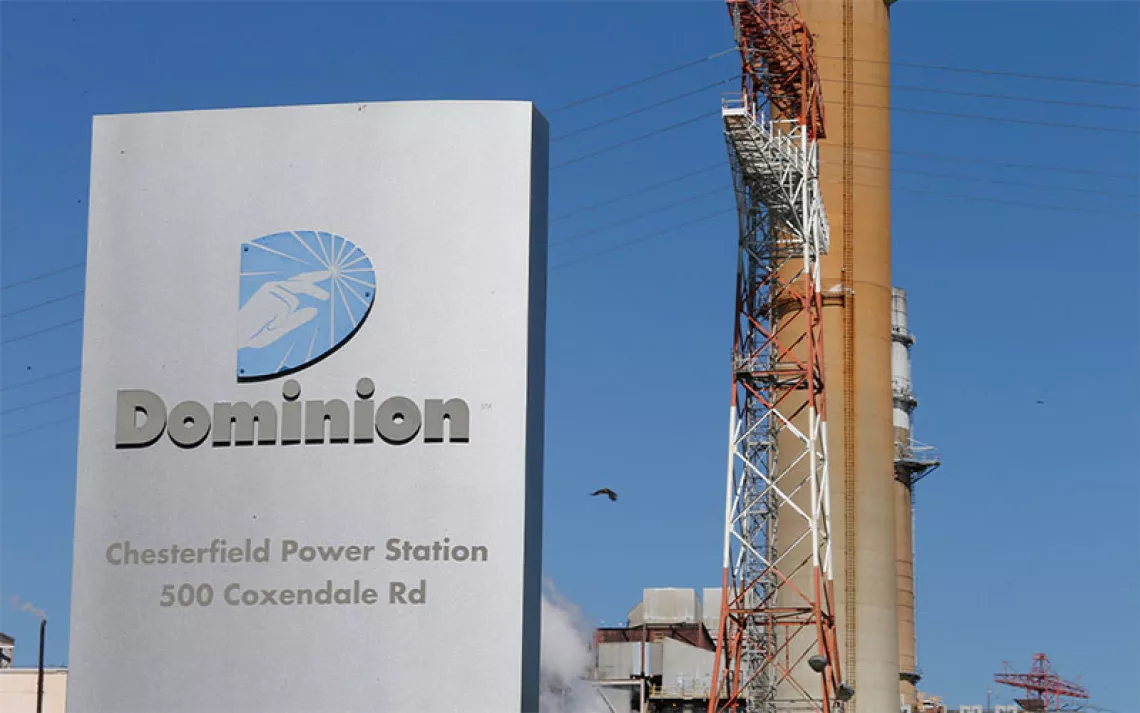Entergy Gas Plant Evokes New Orleans Legacy of Environmental Racism
New Orleans East has a long history of being the city’s dumping ground
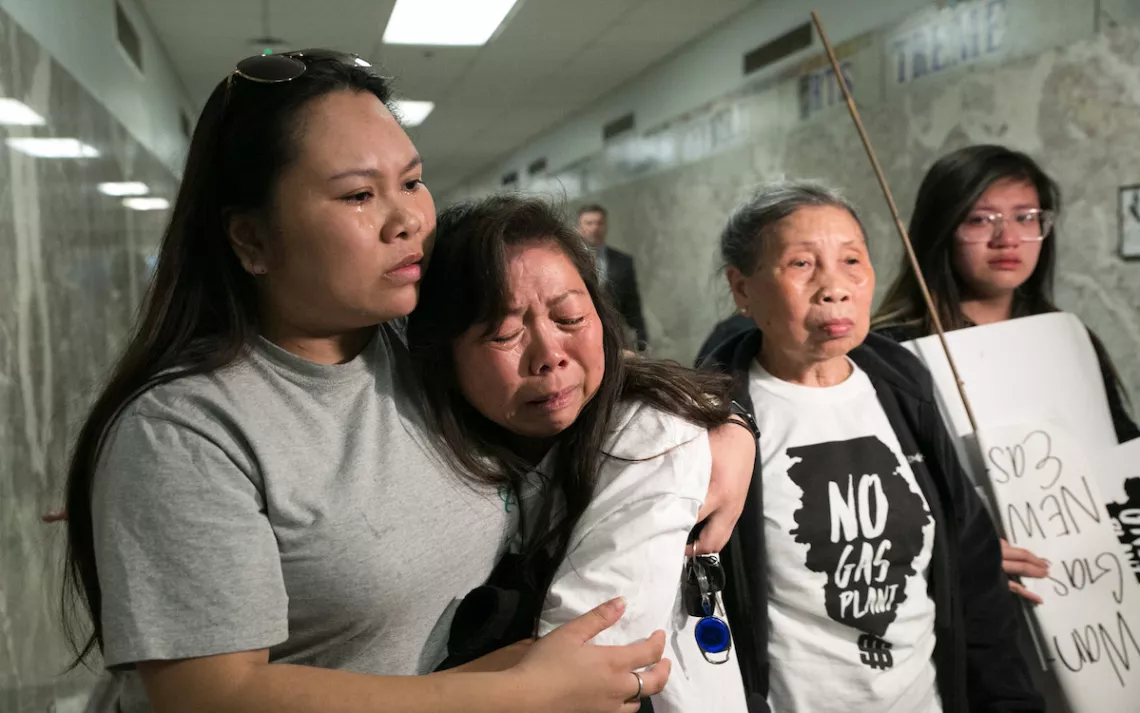
Residents of New Orleans East leaving City Hall after the Council’s decision to build the Entergy plant in their neighborhood. | Photos by Christiana Botic
Beverly Wright was 14 when her family moved into a split-level house on the freshly paved block of Rosemont Place. It was 1962—just two years after New Orleans schools were forcibly integrated. Rosemont Place was the second black subdivision in middle-class, newly suburban New Orleans East.
A 10-mile-long rectangular swatch of land isolated by an industrial canal and the intercoastal waterway, “The East” is essentially an island on the edge of New Orleans. Wright’s father, Morris Bates, worked three jobs to afford the new house and faced resistance from his wife, Evelyn, a descendent of free people of color who settled in the 7th Ward centuries ago. Unlike the house Wright’s mother had inherited in the 7th ward, this one was brand-new and had indoor plumbing. Wright wondered if her family had suddenly come into money.
It soon became clear that their move did, in fact, come at a high price.
White teenagers from the nearby Plum Orchard subdivision would often speed through their neighborhood, yelling racial slurs at Wright and her little sister, Deborah. “I’ll never forget. We were playing in the street,” she recalls. “They threw a rock, and it hit my sister and sprained her wrist.” Around the same time, Wright started to notice low-lying plumes of smoke hovering over trees in the distance, accompanied by a near-constant stench. Back then, she explains, “I didn’t even know what a landfill was, but my dad would say, ‘That’s the dumps burning.’”
Pollution, both visible and invisible, also spewed daily from nearby factories. The Emergency Planning and Community Right to Know Act, which revealed hazardous substances being used by industries in communities like New Orleans East, was enacted in 1986. Until that time, many, like Wright’s father, continued to believe the plants and industries surrounding their homes were benefiting them. “We knew nothing,” Wright says.
Now 70 years old, Dr. Beverly Wright stands in front of her adolescent home on a clear evening in March. Her father’s dream of The East seems to reside in the distant past. Wright’s family is gutting the home for a third time—first there was Hurricane Betsy, then Katrina, and now an asbestos problem. Out front, the road is riddled with potholes, and an industrial-size dumpster is overflowing with garbage. A neighbor approaches Wright to inform her that folks have been passing by her home to unload tires, scraps, and crawfish remains. In more ways than one, The East has continued to be a dumping ground for the city.
Shaped by her adolescence here, Wright has spent the last 50 years researching and combating environmental racism, and she is the founding director of the Deep South Center for Environmental Justice (DSCEJ). For most of her career, she has worked in “Cancer Alley,” the industrial corridor that runs along the Mississippi River from Baton Rouge to New Orleans.
These days, she’s worried about a power plant the city is planning to build in New Orleans East—less than two miles from residential areas, on the most rapidly sinking land in the city.
*
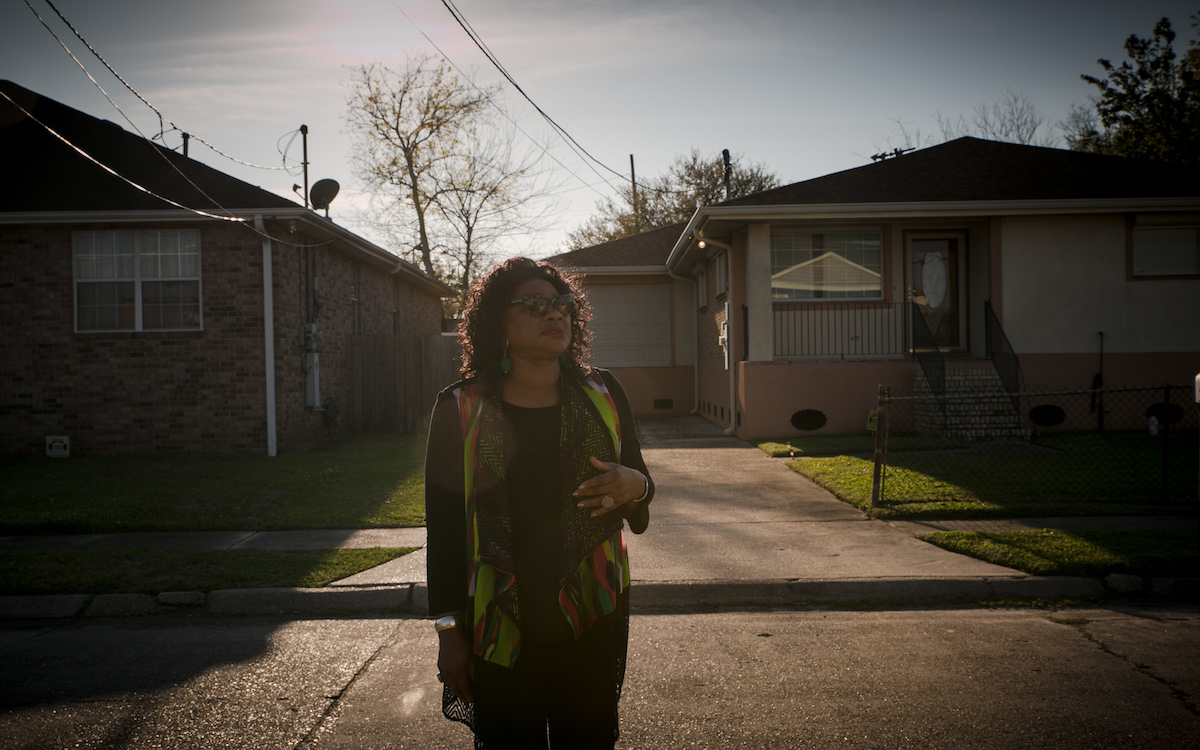
Dr. Beverly Wright looks up at the home her father worked three jobs to buy in New Orleans East, on Rosemont Place.
New Orleans is the only city in the country with the autonomy to regulate the utility company that serves its constituents (most utilities are regulated by counties or states). In March, the city council voted to approve a proposal by Entergy New Orleans (ENO) to build a new gas-powered plant. Councilmembers largely based their decision on the recommendation of their appointed advisors, Clint Vince and Joe Vumbaco. A team of taxpayer-funded, Colorado-based consultants with multi-million dollar annual contracts, Vince and Vumbaco have been working with New Orleans City Council for the past 30 years—they were hired just after the city council began its unique role of regulating the city’s utilities in 1985.
The city council may have also been swayed to vote in favor of the plant by the sea of audience members who showed up to public hearings sporting orange shirts that read “Clean Energy. Good jobs. Reliable power.” Last week a local news agency reported that these audience members were in fact paid actors hired to bolster support for the plant. Entergy denies allegations of astroturfing, but at least four men have gone on record as having been paid to attend the meetings.
When New Orleans elected its first majority-black city council in 1986, Wright and other community members saw it as an important milestone in the fight for racial equity. The city council that voted in favor of the plant was also majority black, which makes the decision to approve the gas plant all-the-more-maddening for Wright. “Changing the complexion of the council has made no difference, so we’re fighting a bigger giant than what we thought,” she says.
Entergy’s new plant is slated to be built on the same Michoud site where three faltering generators have produced electricity on and off since the 1960s. Following Hurricane Katrina, repairs to the flooded infrastructure resulted in extremely inefficient and expensive power generation that added hundreds of dollars to residents’ utility bills. Entergy closed that plant in 2016 as part of what was announced as a $30 million dollar upgrade in its electric power transmission system. Residents hoped this would fix their frequent power outages, which climbed to over 2,000 per year between 2016 and 2017. But rather than tend to the hard transmission lines that would decrease outages, a trio of interests—Entergy officials, New Orleans City Council, and advisors Vince and Vumbaco—has rerouted public discourse and taxpayer dollars back to the Michoud site.
The area where the gas plant would be built looks like a scene of industrial apocalypse. Rusted metal spires frame the hazy sky. High-voltage signs adorn fences blocking off tanks with labels like “DANGER: Sulfuric Acid 400 gals” and “Gas Free Air.” A single generator hums as an acrid, salty stench rises from pools of water that sit stagnant amid long dry grass.
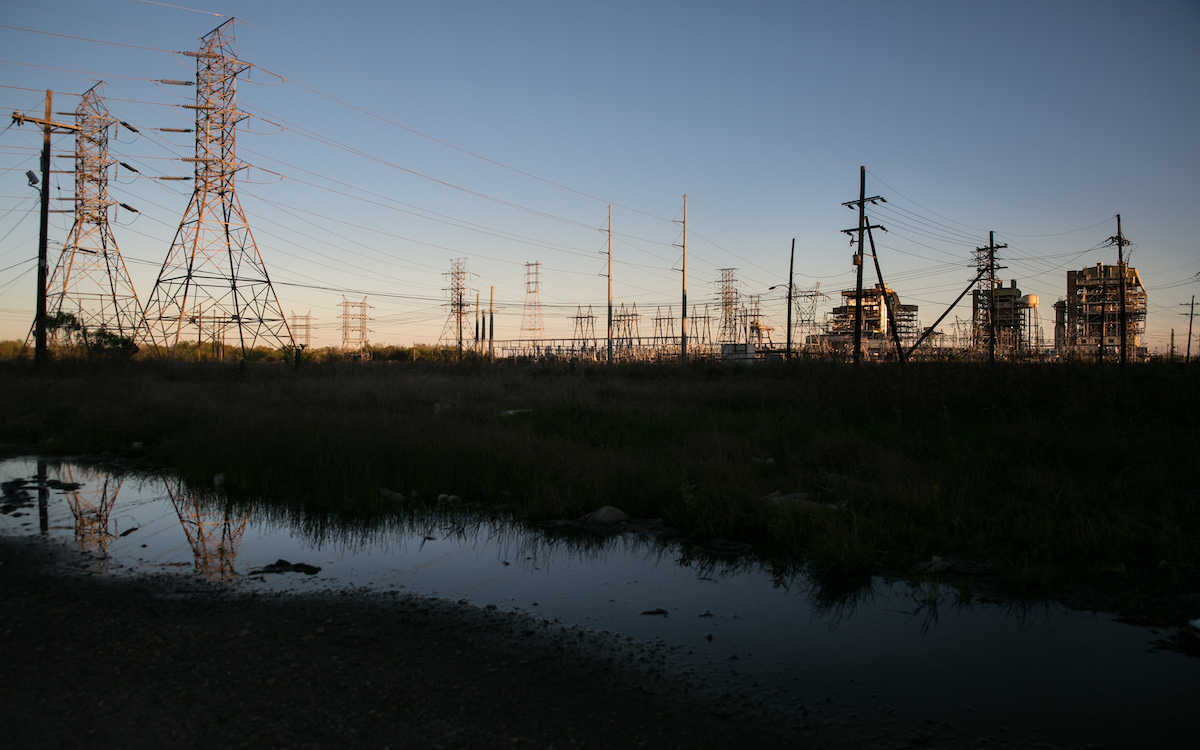
The decommissioned plant at the Michoud site where Entergy plans to build a $200 million gas-powered plant.
Geologists from LSU and the California Institute of Technology have identified Michoud as sinking at a rate up to 3.9 times faster than the city’s average. Part of this is due to natural tectonic activity, but heavy industrialization has accelerated the process. The plant took on five feet of water during Katrina and was decommissioned for eight months. FEMA has designated the site a high-risk flood zone. As the land continues to sink, the potential for flooding will only increase.
If built, the gas-powered plant will cost taxpayers $7 million per year for the next 30 years. New Orleans East resident Tuyet Tran says that members of her community are already forced to choose between buying groceries and keeping the lights on. “I’m not sure if we can bear another increase to our utility bills,” she testified to the Utilities Committee on February 2.
New Orleans is already among the top five U.S. cities where low-income and African American populations face the highest energy burden. Meanwhile, the city has continued to spend millions of dollars each year on the same out-of-state advisors they’ve used for the past three decades, passing this burden on to taxpayers as well. “City council members feel very hitched to the perspective of their advisors,” says executive director of the Alliance for Affordable Energy, Logan Burke. Opponents of the plant worry that this long-standing relationship between the appointed advisors, Entergy, and the council has gotten far too cozy to be in the public’s best interest. Previous Councilmember-at-Large Stacy Head agrees, stating that council must change its regulatory system “to ensure that the council and Entergy give full consideration to more progressive options.”
As for these more progressive options? “Entergy has sought to undermine anything that might be an alternative solution,” Burke explains. “Entergy made renewables look unattainable or too expensive for New Orleans by using outdated, really old assumptions for the cost of solar and wind.” A representative from PosiGen, a solar panel company in Louisiana, said the company “would have been thrilled to have the opportunity to bid on this thing,” but there was never an all-source competitive solicitation.
Councilmember-at-Large Jason Williams disagrees, contending that, “ENO did, in fact, solicit bids for the engineering, procurement, and construction for the plant from companies it was aware of that had the relevant experience.” However, ENO reached out exclusively to a handful of companies it had worked with before and appeared determined to use the Michoud site, which it owns and which already has existing infrastructure for a gas plant.
Upset by Entergy’s lack of transparency and apparent disregard for community input, residents of New Orleans East did the only thing they could: protest. Armed with posters and t-shirts reading “No Gas Plant,” citizens rallied at City Hall and spoke at the public hearings, which were held between January and March of this year.
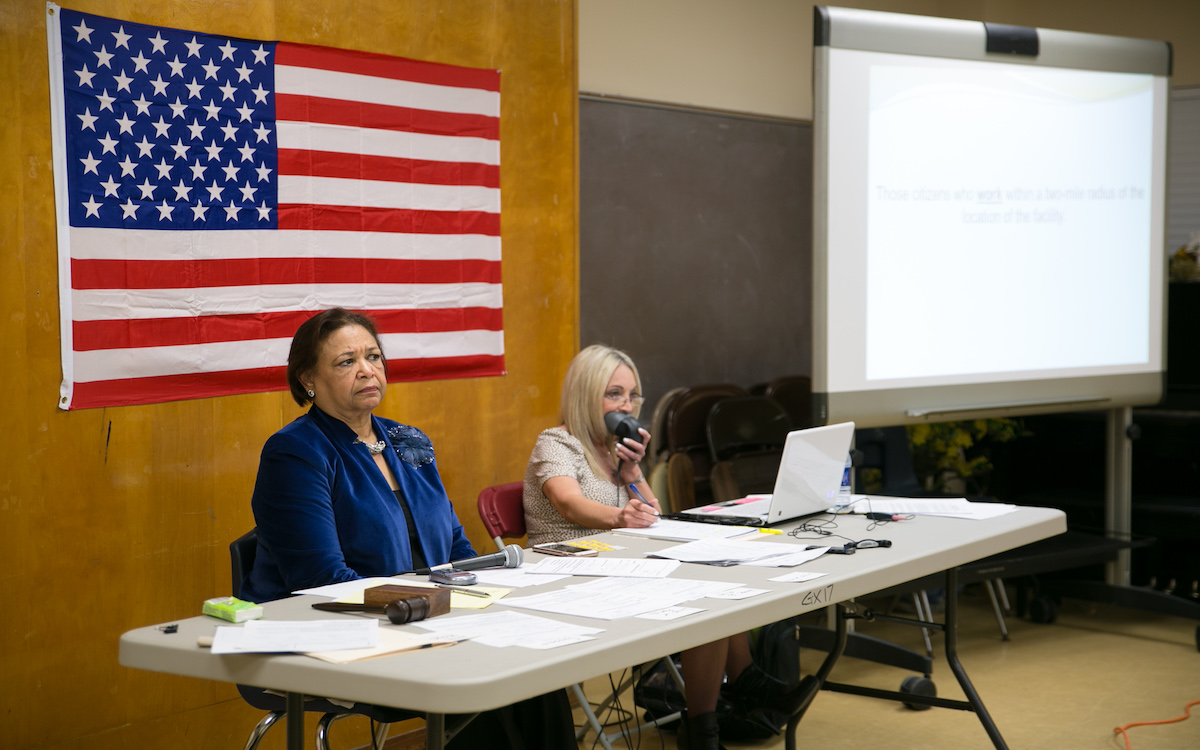
The Louisiana Department of Environmental Quality holds a public meeting on March 6 at Mary Queen of Vietnam
As the meetings progressed, Entergy’s rationale for the plant seemed to shift until it landed on one that resonated. After admitting that the new plant would not prevent the thousands of power outages New Orleans experiences annually, the company claimed it was necessary as the city’s last line of defense during emergency situations in which multiple transmission lines failed. Though the probability of such an event happening is low, the scenario struck fear among the council and many constituents. After all, New Orleans is vulnerable to natural disasters. Councilmember-at-Large Williams said, “Large swaths of customers without power, perhaps for days, with all of the attendant health and safety risks that would bring, weighed very heavily on our decision.”
“After so many contributions these folks have made to the city, the city ignores them,” Tony Tran laments. Tran, a Vietnamese community elder and Parish Coordinator at Mary Queen of Vietnam Church, came to New Orleans as a refugee. Now, he says, “we may have to plan for another exodus.”
The East’s diverse community—along with its Vietnamese and African American residents, it’s home to a robust Latino population—has managed to unite to fight off environmentally hazardous projects before, most notably, in 2006. When the city needed a place to dump the massive debris left in Hurricane Katrina’s wake, it hastily built a landfill for the wreckage in New Orleans East. The site was located directly between residential neighborhoods and Bayou Sauvage, the largest urban wildlife refuge in the United States. After then Mayor Nagin attempted to circumvent due process to open the landfill, communities in The East mobilized, organized, and successfully halted the operation. Now they are mobilizing in the face of this new threat.
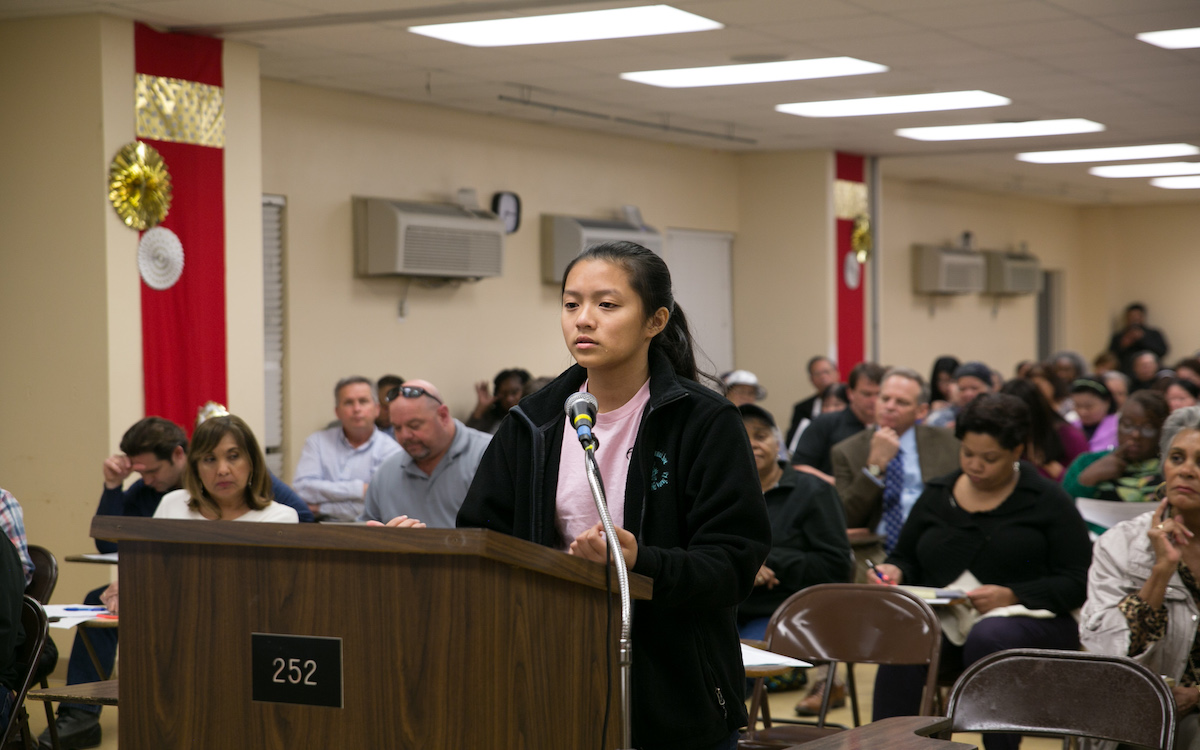
Gabrielle, 14, speaks at a public LDEQ hearing on March 6 at Mary Queen of Vietnam Church in New Orleans East.
Like many, Wright grew up believing that electing people of color to local government would change the trajectory of the city, and begin to amend its painful past. On May 7, the city’s first Vietnamese councilmember, Cyndi Nguyen, was sworn in, as was its first female, and black female mayor, Latoya Cantrell. A central element of Cantrell’s campaign platform this past fall involved her commitment to restoring wetlands as part of efforts to build a more resilient New Orleans. Her support of the gas plant conflicts with those months of campaigning. Before voting yes at the City Council Meeting on March 8, Cantrell took her seat next to fellow council members and listened to six hours of public testimony, including that of Wright.
“I don’t usually get emotional, but I’m really emotional about this,” Wright said. “My mother was a card carrying NAACP member, fighting for the vote, but she had to hide it in her pocket,” she continued with shouts of encouragement from the crowd. “We believed changing the complexion of the city council would make our life better. It’s not happening.”
The racial complexities of the controversy extend beyond city government and into the boardroom of ENO, where an African American, Charles Rice, is currently the President and CEO. When community members expressed upset at the rumor that Rice will get a raise if the plant is built, councilmember (and New Orleans East representative) James Gray came to his defense. “When I look at the leadership of Entergy, I first of all see three black men who are from New Orleans,” Gray said, “and I remember the time that many of us in the room would have cheered the fact that they had an opportunity to be the leaders, and [...] the fact that they were doing a good job for their company.”
Wright and other community members reject this line of thinking. They point to Louisiana’s long history of incentivizing companies through tax exemptions to build out industry on large swaths of the state’s land, including former slave plantations—a policy that has continued to make executives rich, while keeping Louisianans poor. “We forget that history tells us a lot," Wright says. “There’s an absolute inverse relationship between pollution and wealth.” She resents the suggestion that people made poorer by industries like ENO should cheer on leaders like Rice just because they are the same race, and she and other activists have begun to question if leaders of color in New Orleans—whether they be executives at ENO or members of the city council—have become a part of the very system they were expected to reshape. In her address to City Council, Wright concluded her comments about race by saying, “You’re doing the same thing they did to us....I’ve never been more disappointed in all my life.”
This year, New Orleans is celebrating its 300th anniversary, but the controversy over the gas plant exposes an ugly current that runs beneath popular tricentennial messages of resilience, strength, and progress. When the council voted 6-1 in favor of the plant on March 8, then-mayor-elect Cantrell explained her yes vote as a matter of “looking at [the situation] holistically and what the needs are citywide.” This reasoning troubles Wright, who notes, “Whenever you talk about greater good, I can tell you exactly which communities will suffer.”
Before casting the single dissenting vote, councilmember Guidry addressed the room, saying “the cost of the plant will be on your bills for the next 30 years. The plant’s technology would likely be obsolete before you finish paying for it.” According to projections by the U.S. Geological Survey, portions of New Orleans East, including the southern edge of the Michoud site, could be underwater before ratepayers cover the full cost of construction.
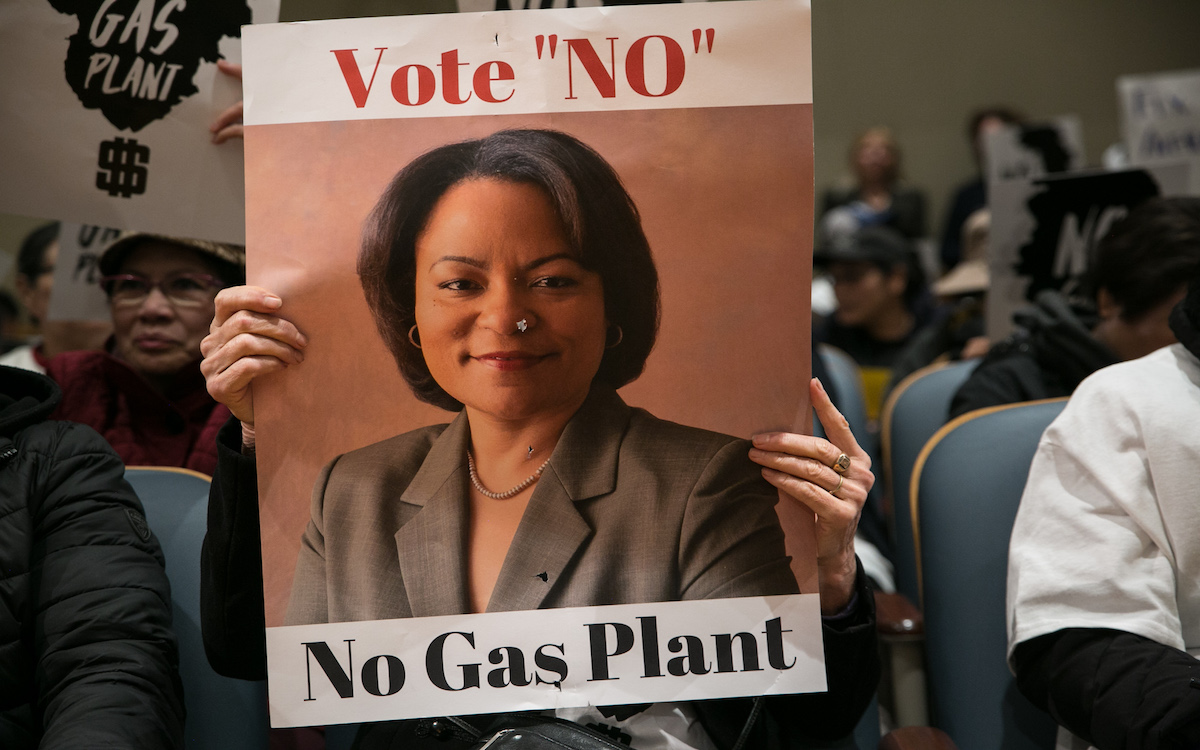 An opponent of the plant holds up a sign urging Mayor-Elect Latoya Cantrell to vote no.
An opponent of the plant holds up a sign urging Mayor-Elect Latoya Cantrell to vote no.
*
“I’m still connecting the dots,” Wright says as she looks up at the house her father bought 56 years ago, recalling the smoke and stench that regularly passed through her neighborhood. “Those horrible rotten egg smells would come through here,” she remembers. “My dad would say, ‘smells like money,’ because we really thought all of these industries were making us rich. We didn’t know the side effects.” Half a century later, Wright says, “our standards are higher than that, because we know better.”
ENO claims it will operate the plant within given environmental standards, but many nearby residents say that’s not good enough. A broad coalition of environmental and community groups is currently seeking legal action to stop Entergy from moving forward with the Michoud plant. On April 10, organizations including the DSCEJ, Alliance for Affordable Energy, 350 New Orleans, and the Sierra Club petitioned New Orleans City Council for judicial review.
In response to the news that paid actors attended the public hearings, the coalition is filing letters of complaint with the incoming New Orleans City Council, the Orleans Parish District Attorney’s office, as well as the Louisiana Attorney General and State Board of Ethics. Leaders at the DSCEJ say this might finally signal a watershed moment. Monique Harden, the Assistant Director of Public Policy says, “The good news is that in Louisiana, an oil and gas state, the only support [for the gas plant] that could be mustered is paid actors. That says a lot.”
Wright says that there has long existed an assumption that sacrificing parts of New Orleans—from dynamiting levees to divestment from poor neighborhoods—can save the rest. “Some people seem to think [New Orleans] will float with the drag of New Orleans East, but the way I see it, that will eventually drag down the whole city.”
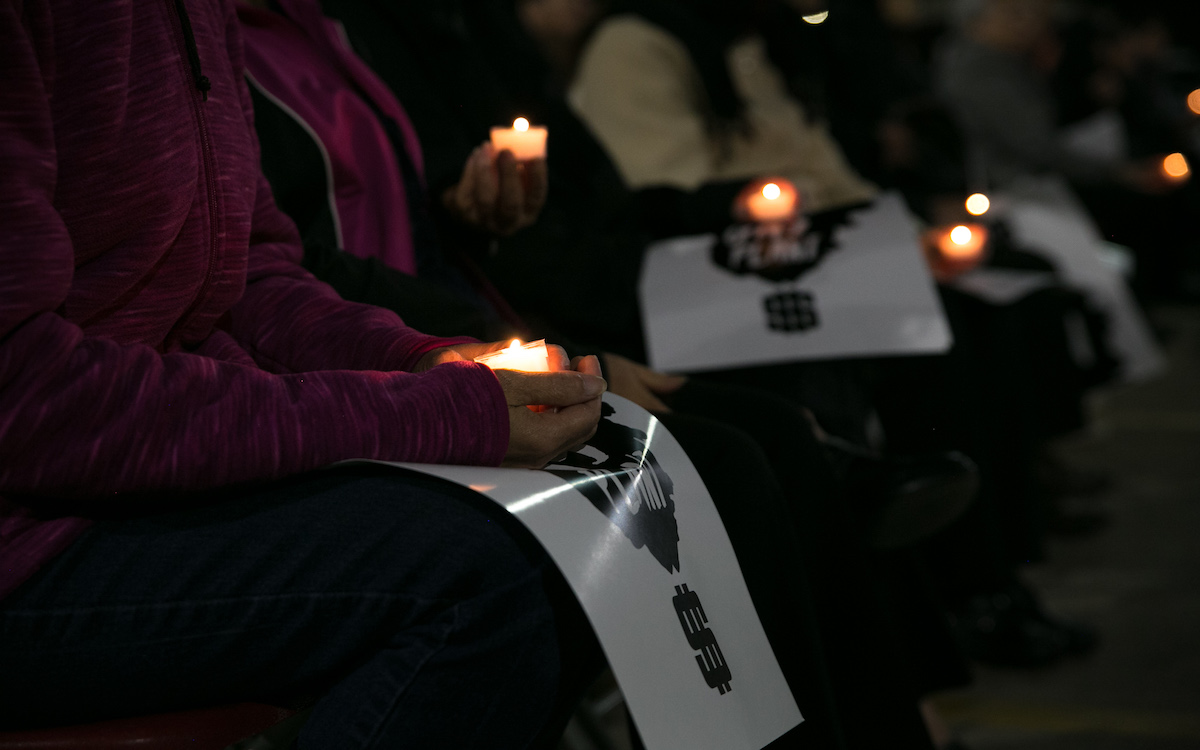
Residents of New Orleans East hold “No Gas Plant” signs and candles during a vigil at Mary Queen of Vietnam Church.
 The Magazine of The Sierra Club
The Magazine of The Sierra Club
